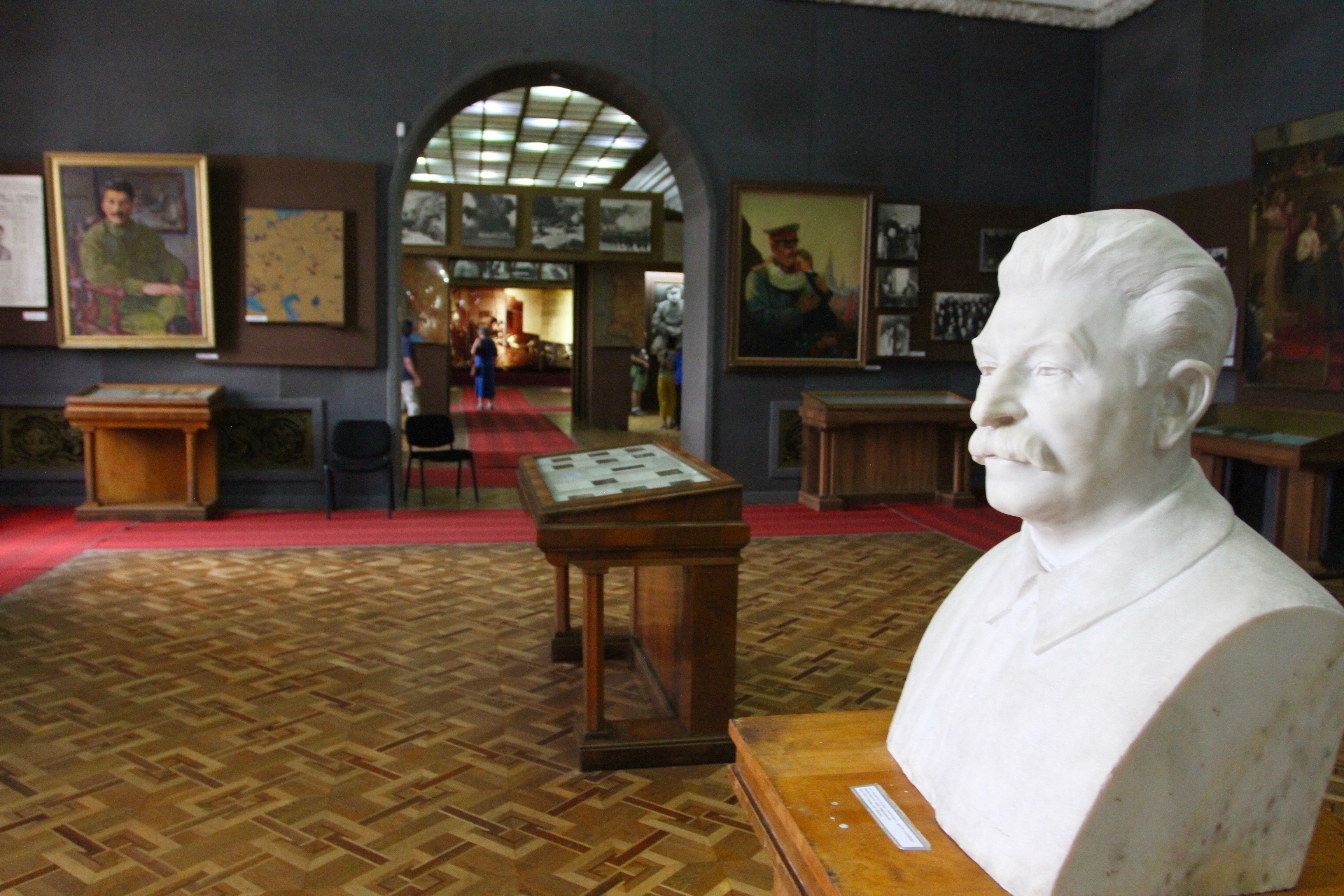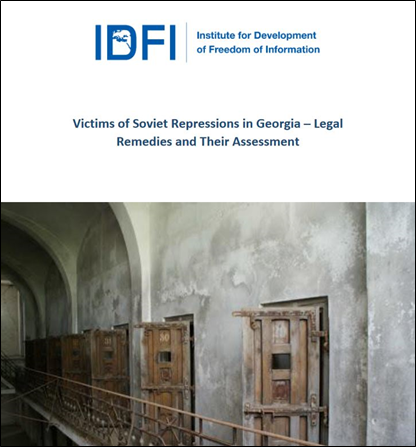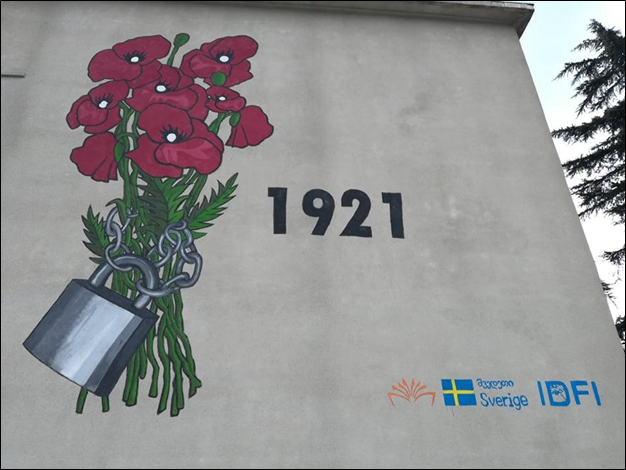Confronting the Complexity of Georgia's Communist Past and Soviet Nostalgia. An Interview with Anton Vatcharadze
Anton Vatcharadze is the Memory and Disinformation Studies Direction Head at the Institute for Development of Freedom of Information (IDFI) in Tbilisi, Georgia. His work is focused on evaluating the openness of state archives in Georgia and other post-communist states. In addition, he examines the effects of memory politics as well as that of disinformation on Georgian society. Vatcharadze also facilitates humanitarian studies and potential student awareness at the University of Georgia.
Willa Davis (Contributing Writer at the Estonian Institute of Historical Memory): Would you mind telling us a little bit about the Institute for Development of Freedom of Information (IDFI)?

Anton Vatcharadze: The Institute is an NGO that was founded in 2009 by Giorgi Kldiashvili and Levan Avalishvili. At the time, both the openness of archives and the general improvement of access to public information was a pressing issue in Georgia. IDFI monitors governmental activities and openness, public procurement, and general issues related to the freedom of information.
One of the most interesting projects in the field of historical research on the Soviet Union was the creation of the first database, Stalin’s Lists of Georgia, related to the Great Terror (1937–1938). It includes data on the people who were executed in Georgia by Stalin’s direct order. In addition, we write articles on Soviet history, starting from the first Democratic Republic of Georgia (1918–1921) up until the national movement of the late ’80s and early ’90s.
IDFI has also been working on detecting and debunking historical propaganda. The Institute is working on expanding its focus to address propaganda as well as disinformation and memory studies.
What kinds of projects do you focus on as the Head of the Memory and Disinformation Studies Direction at IDFI?
I started working at IDFI four years ago, and I focused on a project about the openness of state archives. We have continued working on these projects and have evaluated the openness of archives across 18 former Soviet and Eastern Bloc countries. Within the ranking, we highlight the features of each archive and provide archival recommendations.
Our methodology covers issues such as the relationship between researchers and archives and the extent to which archival openness is ensured by a country’s national legislation.
While we are not planning to evaluate state archives in 2021, we have published a study that examines how different archives acted during the COVID-19 pandemic. For example, in the Ukraine, the archives carefully adapted to the new reality of COVID-19. Following the publication of this study, IDFI introduced a proposal to the Parliament of Georgia about amending the national archives law.

We are also working on an educational project on disinformation and memory studies, with a private Georgian university. We have developed study courses where students, public and civil sector employees, and media personnel will choose from different modules.
We have also established partnerships with the institutes of national remembrance in Estonia, Poland, and the Ukraine, and CSOs in the Czech Republic. One of the main goals of this effort was to exchange research on the first mass graves, which contain victims of Stalin’s terror, that were discovered in Batumi, Georgia in 2019. We work with local actors to provide studies about the mass graves and with international partners who consult us on how to proceed.
We provide archival research as well and write articles based on novel archival documents. In addition, we hold various awareness raising campaigns, which include social media activities, exhibitions, and publications. Finally, we conduct interviews with the victims of the Soviet regime and their descendants.
Unfortunately, a great number of people outside of Georgia do not know much about the history of the Georgian Soviet Socialist Republic (formerly part of the Transcaucasian Soviet Federalist Republic from 1922 to 1936), which lasted from 1921 to 1991.
A) Would you mind giving us an overview of how the communist government came to power?
Georgia was Sovietized forcibly — in 1921, the Red Army crossed Georgia’s borders and there was one month of intense fighting between the Georgian Army and Bolshevik Red Army. This resulted in Georgia’s occupation by the Bolshevik regime.
In 1922, when the Soviet Union was established, Georgia, Armenia, and Azerbaijan became part of the Soviet Union as the Transcaucasian Socialist Federative Soviet Republic (TSFSR). Tbilisi, the Georgian capital, was the political center of the TSFSR.
In our national narrative, we consider the events of 1921 to be a Russian occupation. However, many Georgians were part of the leadership of Bolshevik Russia, such as Joseph Stalin (Ioseb Jughashvili) and Sergo Ordzhonikidze (Grigol Orjonikidze).
It was a matter of honor and prestige for these leaders to Sovietize Georgia. In the 1920s, when Azerbaijan and Armenia were Sovietized, Georgia was left as an independent island inside the South Caucasus. The Bolshevik leadership also had economic interests in Georgia because the main transportation road from Baku’s oil reserves to the Batumi Port was through Georgia.
Georgian society reacted to this part of history ambivalently: the majority of society supported the Menshevik government of the first Georgian Democratic Republic (1918–1921). However, there was also a part of Georgian society that supported the Bolsheviks. This is what the Bolshevik forces used to justify their occupation — they wanted to represent the occupation of Georgia as an internal uprising.
In 1921, when Georgia was Sovietized, the government went into exile in France and took all the archives with them. Once historians started to actively study this period, they realized that Georgia was one of the first, real examples of democracy during that time. The first Democratic Republic still has many notable achievements that we can learn from (e.g., women’s political rights and human rights). Even if Soviet propaganda painted the government as traitors, their decision to leave the country and struggle against Bolshevik Russia in exile is noteworthy.
After the Bolshevik occupation in 1921 and Sovietization in 1922, there was a big uprising in 1924. The Georgian people expressed their will with weapons, in an effort to fight against the occupant power. This uprising was harshly suppressed. More than 800 people were executed and several thousand were sent to prison.
B) How does Georgian society feel about the political repressions that were carried out during the communist government’s tenure? Do these memories of political repression still affect people’s historical memory?
Yes. These memories still affect Georgian society — especially during the period of independence (post-1990s) when people found out that a large part of Georgia’s intelligentsia was executed during the Great Terror.
The memory of 1924 is also still alive in Georgian society. All the studies that we are conducting are focused on examining these events in more detail.
The repressions started from the day Georgia began to be Sovietized in 1921 and continued until the collapse of the communist regime. The biggest wave of repressions took place under Stalin’s regime. After his death, repressions took on other forms (e.g., persecution of dissidents and locking people up in psychiatric institutions).
Unfortunately, there are people who still admire the regime and Joseph Stalin. They feel that he is an important figure because he was Georgian and became the ruler of one of the world’s biggest empires.
How does Georgian society deal with the legacy of Georgian-born Joseph Stalin?
A) How does Stalin’s legacy influence people’s historical memory of the communist period?
This is a very complicated question. According to the study of the Levada Center in Russia, more than 40% of Georgians still think that Stalin was not a bad person. Georgians have almost the same level of nostalgia as do the Russians.
This can be explained by the fact that Stalin was born in a small country and became the leader of one of the world’s biggest countries. The positive image of Stalin is cultivated: Those who study disinformation in Georgia know that his image is supported by Russian contemporary propaganda, because it uses history as a propaganda tool.
During the Great Purge, more than 30,000 people were repressed in Georgia and almost half of them were shot dead. The other half were exiled to Central Asia and Siberia. Today, when you talk about the repressions, there are two popular messages used by propaganda:
a) Stalin was not aware of what was taking place.
b) Traitors who were fighting against the Soviet regime deserved to be executed.
Georgian society’s relationship with Stalin is controversial, but it has a logical correlation — surveys show that people over a certain age think positively about Stalin. Within younger generations, however, positive attitudes towards Stalin are decreasing.
During the previous government’s time in office (2003–2012), a huge statue of Stalin was removed from Gori, Stalin’s hometown. There is a lot of controversy surrounding this event. Why was it removed at night? Why was there no public discussion about removing the statue?
During the current government’s tenure, people have started to re-erect Stalin statues. In some cases, these statues have been removed. There are, however, still villages where statues of Stalin stand, because the local and central governments try to avoid conflict with the locals.
There is also the issue of Stalin’s museum in Gori, which is a commemoration of his life. There was a plan to convert this museum into a museum about Stalinism and repressions, but it currently looks the same as it did during Soviet times.

During the Great Purge (1936–1938), thousands of Georgians were arrested, deported, and executed by Soviet authorities.
Two years ago, in 2019, a mass grave containing victims of the Great Purge (1936–1938) was found in the Georgian town of Khelvachauri.
A) How has this discovery influenced Georgian society’s view of the country’s former communist government?
This event had a big effect on Georgian society. Prior to this event, we had explained to people that thousands of people had been executed. However, when Georgians saw these images of mass graves, I think it affected them even more.
According to media coverage and Facebook comments, the public’s reaction was striking. When Georgians saw how people’s hands had been tied back, how they had been shot from behind, and how they had been put into one mass grave, it really shocked them.
There are still Georgians who claim that the victims deserved this punishment, because Stalin would not have succeeded in winning WWII without these repressions. This point is inaccurate, because during the Great Purge Stalin purposefully executed professional military officers in both Russia and Georgia.
During the WWII Battle of the Kerch Peninsula, there were more than 500,000 victims from the Soviet Union, including four of my relatives. This was Stalin’s responsibility — the Soviet commander in chief was Lev Mekhlis, former editor of the Pravda newspaper, because most of the professional military personnel had been executed during ’37 and ’38.
B) Has this event affected levels of Soviet nostalgia amongst older generations?
We do not have a special survey or research on this matter, but I think older generations were also affected. During an interview, the son of one of the victims told us that his father had been executed, and that the family had had their houses expropriated. They were then forced to live in a cattle pen. He stated, however, that he still admired Stalin. These kinds of comments are very common in Georgia.
So Soviet nostalgia is still very strong?
For many of these people, the images of Stalin and Lenin were like those of a god or religion for them. In March 1956, people participated in mass protests in central Tbilisi after Khrushchev’s Secret Speech. At least 21 young people who came out to defend Stalin’s name died because the Soviet state suppressed the protests.
When this de-Stalinization process was initiated by Khrushchev, he spoke out against Stalin and his crimes, and mentioned Stalin’s Georgian background in a negative way. This has led Stalin to possesses a parallel image within our nationalist pride.
In 1956, someone brought the flag of the first Democratic Republic of Georgia to the streets while defending Stalin. Stalin’s image is ambiguous and has many faces. It is very hard to examine Georgian history from one perspective.

How is Georgia’s communist legacy addressed and studied today?
First of all, it is studied at a very low level, despite the fact that organizations like IDFI exist. There are only two non-governmental organizations that actively study Soviet history in Georgia. It is not studied as systematically as we would like it to be.
One of the obstacles we face is the closed character of the Georgian archives. There is a law on personal data protection, which includes a 75-year period of non-disclosure of personal information. Therefore, the archives refuse to issue almost all types of documents from this period.
The 75-year non-disclosure period means documents from 1946 onward cannot be accessed. The most notable events that took place after WWII are not well-studied because the archives do not provide people with free access to these documents.
It is about legal and law enforcement issues. We already proposed the types of changes that should be made to the legislation, but our proposal was rejected. We will try to modify and present our proposal again.
In countries like the Ukraine, one can freely use these kinds of documents for scientific research. If a researcher reveals any personal information, then they are held responsible and not the archival institution. In Georgia, it is the opposite, and the archives avoid allowing researchers access to documents.
The second obstacle is the high price of photocopying in the archives, which costs about $1 per page. In most state archives, you can take as many photos as you wish with your mobile phone. This is prohibited in Georgia.
When you write an article, you often need to go through 500 to 1000 pages, and no independent researcher is able to spend $1,000. Nonetheless, our legislative proposal was rejected because the archives argue that they will lose their income. This is not a legitimate reason, because the National Archives only make about $,8000 a year from photocopies.
A) Is there a culture of remembrance for the victims of communism?
No. If we compare Georgia to other countries where monuments are erected, parks are home to memorial walls, and where projects are implemented, the Georgian case looks very poor.
This trauma has not been a matter of importance for the Georgian government. In 1998, July 22nd was established as a day of commemoration for the victims of Soviet terror. On this day in 1937, a famous Georgian writer, Paolo Iashvili, shot himself in the Writers’ Union Building. However, in 2021, only IDFI organized an exhibition to commemorate the victims.
B) What practices are used to commemorate and compensate victims?
A one-time compensation was issued to victims in 2010, ranging from $700 to $1,300 US Dollars. There is also an unimaginable living subsidy for the victims — 7 Georgian Laris. IDFI continues to advocate for an increase in this subsidy, but the government has rejected our proposals.
There are currently 9,700 people who are victims of Soviet repressions in Georgia. Their number decreases every year because these people are very old. Between 2019 and 2020, 700 victims of repression passed away. We asked the government to raise this 7 GEL to at least 44 GEL, but they rejected our proposal. This issue has not been a priority for the Georgian government.

What kinds of tools or practices can be used to shed light on a country’s totalitarian past if issues of political memory or disinformation arise?
We use archival research, articles, and blogs. We also have a Facebook page called Stories of the Repressed, where we post the stories of various people and victims of repression. We also focus on public education and open lectures. We use tools like exhibitions and the publishing of materials, such as memorial albums of notable personalities from the first Democratic Republic of Georgia. We also designed and painted a commemorative graffiti in Kutaisi. Furthermore, Zoom lectures became very popular in the last two years, because we are able to have a greater impact on society at a lower cost. We have also held essay and illustration competitions.

What projects will the Institute for Development of Freedom of Information be working on next?
We will continue building our database. The Stalin’s Lists database currently only includes 10% of the list of repressed persons. We will also continue to advocate for the openness of archives. We want to push the archives in Georgia to publish documents that are of interest to society and to change the practice that limits researchers’ access to documents because of the inflexible nature of the personal data protection law.
We will work with institutions like the Estonian Institute of Historical Memory and the Polish Institute of National Remembrance. We are also actively working with the Georgian occupation museum because its content needs to be reexamined.
A number of different projects are being launched, especially when it comes to disinformation, because it is a huge challenge for our society today. Furthermore, we want to relate disinformation studies to memory studies.
Where can readers learn more about the history and politics of communism in Georgia?
I recommend visiting our website. We are also launching a new website called History Project GE where we will publish our articles. There will also be an open source for books, albums, and other articles. There are also interesting books by historians and scholars, such as Edge of Empires: A History of Georgia by Donald Rayfield, The Making of the Georgian Nation by Ronald Grigor Suny, Familiar Strangers: The Georgian Diaspora and the Evolution of Soviet Empire by Erik Scott, and Georgia after Stalin: Nationalism and Soviet Power, a collection of articles, including two articles by IDFI’s founders, edited by Timothy Blauvelt and Jeremy Smith.